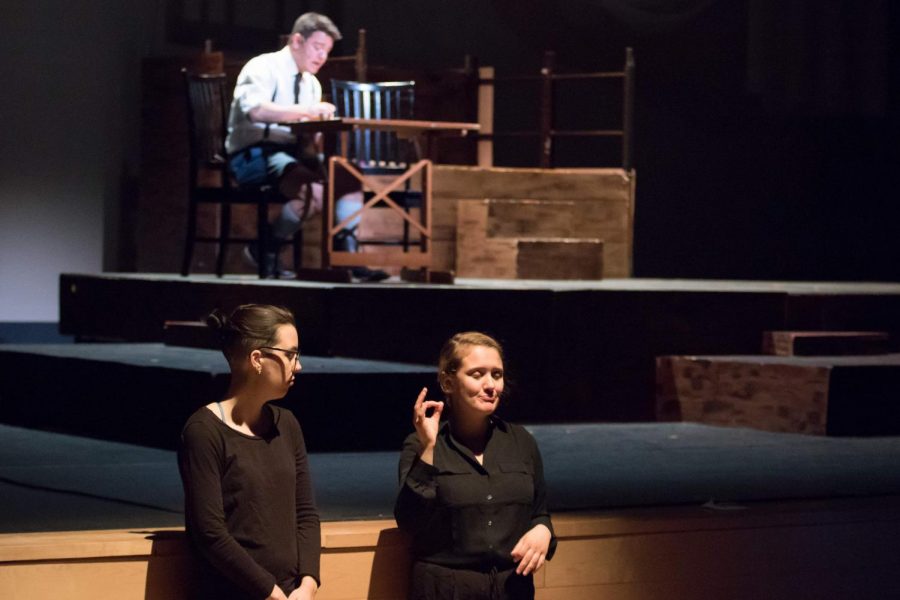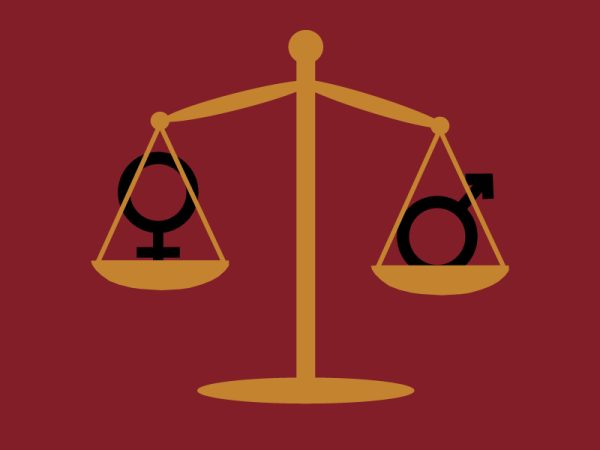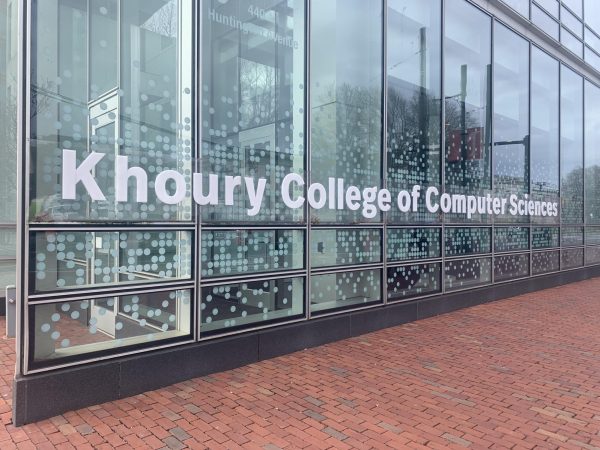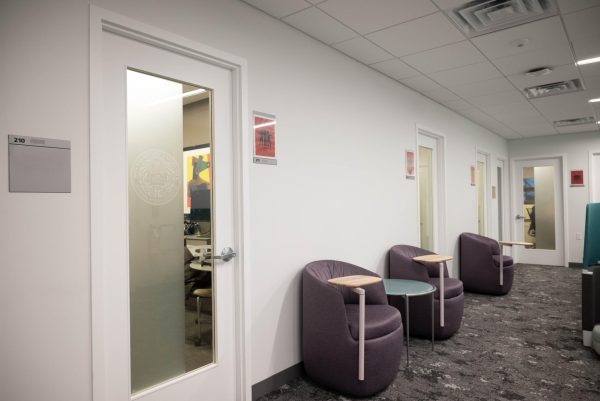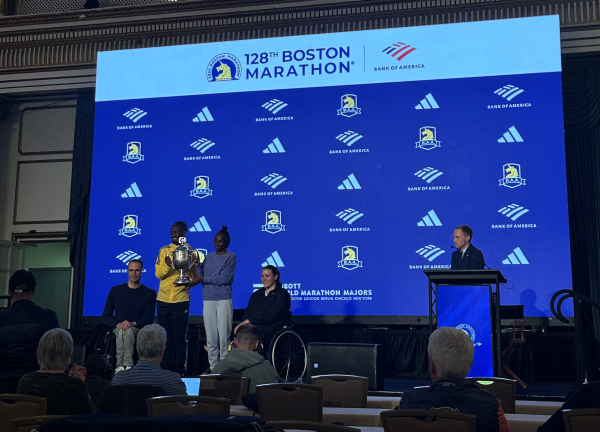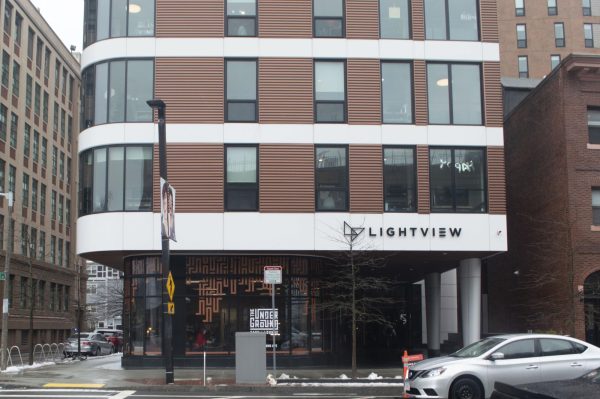Student sign language interpreters help deaf community access music
Photo courtesy Claire Pettit, NU Stage
Members of NU’s ASL club interpret a performance of NU Stage’s “Spring Awakening” over the weekend.
March 27, 2019
When performers sang “Touch Me” from the musical “Spring Awakening” at Northeastern’s Blackman Auditorium Friday and Saturday night, there were four students standing at the corner of the stage “singing” with them — with their hands. They were American Sign Language, or ASL, interpreters helping deaf audience members enjoy the musical.
“Deaf people can enjoy music,” Laurie Achin said through an interpreter. Achin is a deaf professor at Northeastern who teaches ASL. “It doesn’t have to be through your ears. It’s not all about sound. You can feel it, see it and dance to it.”
The four student interpreters were from Northeastern’s American Sign Language Club; the university’s theater club, NU Stage Musical Theater Company, produced the musical.
Anna-Reine Beaulieu, one of the interpreters and a fourth-year ASL major, said the ASL club interpreted the theater club’s production of “Cabaret” last semester and they decided to continue the collaboration.
Beaulieu said Achin translated the musical into ASL and the four interpreters practiced on their own. They volunteered for the role and prepared for a month.
Listening to music comes in many forms
Achin said there is a wide range of individuals in the deaf community. Some can hear a little with a hearing aid while others are fully deaf. However, all are able to experience music through vibrations.
When deaf people listen to music, they put on large headphones, turn up the volume and touch the speaker to feel vibrations, she said.
“But at a theatre, typically it is two to three times as loud as everyday music,” Achin said. “It is guaranteed they can feel vibrations on the floor. That is why deaf people like going to the theatre.”
Achin listens to music by matching a song with numbers and memorizing it by breaking it into eight-beat segments and counting. It usually takes her two to three weeks to memorize a song. She said she can also feel the music by dancing to it.
“If it is a happy song I might do something like this.” She waved her arms and bent her knees.
“If there was a very slow song I might do something like this.” She touched her heart with her hands and frowned, meaning heartbroken.
“Hearing people typically just stand there while deaf people will use their body to interpret the music,” Achin said. “Sometimes deaf dancers are better than hearing dancers because they are not paying attention to the sound. They are paying attention to the feeling. They let their body interpret the music.”
Achin said there are generally four ways to help deaf people access the theatre: The first is having a captioning device or a live sign language interpreter. The second is having hearing artists and deaf artists both on the stage.
For example, the lead role of a musical is performed by a hearing artist and his wife is performed by a deaf artist. When the lead role speaks, his wife will do ASL to interpret his words because she is deaf and she knows ASL. And when his wife is speaking in ASL, someone backstage will read her lines through the sound system as she signs. In this way, the show is accessible to both hearing and deaf audiences.
The third way is having deaf theatres, like the National Theatre of the Deaf in New London, Connecticut and the New York Deaf Theatre in New York City. Most performers, directors and managers of those theatres are deaf and use ASL.
A fourth alternative is to use lights as a means to show the rhythm.
“If it is heavy metal and dark music, they would have dark lighting, like red and black flashing. If it is a happy song, they would have yellow, pink or green light flashing with the rhythm,” Achin said.
She said although there are many ways to help deaf people access theatres, many theatre companies do not like to do it because of the cost.
She also said she worked with the Boston Symphony Orchestra to add abstract concepts to a symphony whose theme was protecting the environment and saving marine animals.
“What we did was something like this, the whale coming up and the tail going down,” she said.
To demonstrate, she extended her thumb and smallest finger while holding the three middle fingers curled, like the fin of a whale. She moved her hand up and down like a whale was swimming up and down.
Interpreters and deaf artists provide access
Outside the theatre, some ASL interpreters work at live music festivals to help deaf people enjoy music.
“We want to provide the access that deaf audience deserves,” said Kyla Wilkenfeld, a freelancer interpreter from California who has interpreted live music festivals for eight years. “When I am interpreting the music, I am providing the same access and enjoyment I get to somebody else.”
To help deaf audiences feel surrounded by the events and know what is happening around them, ASL interpreters not only interpret lyrics but also feedback from the crowd and the beats, like a guitar or drum solo, Wilkenfeld said.
She said she holds an air guitar for the solos. Her hands move up and down with the pitch. For longer notes or held-out sounds, she holds out the sign.
Wilkenfeld said it usually takes her a month to prepare for one artist’s performance, which is about 90 minutes, and about three months to prepare for a music festival.
“It is the same way I would work with Shakespeare,” Wilkenfeld said. “I have to do the research of when the artists wrote the songs, where they were emotionally at that moment, what happened in their life and what was the meaning behind the metaphors. I try to find signs that both match the rhythm and the meaning. And from then on, it’s just a lot of practice.”
In most cases, interpreters cannot access the artists before the show because the artists are so busy, so they have to work on their own, Wilkenfeld said.
More deaf people have attended live music festivals recently, said Lindsay Rothschild-Cross, a freelance ASL interpreter from Texas who has interpreted live music shows for five years.
Rothschild-Cross said last year, about 90 deaf people went to the Austin City Limits, a music festival held in Texas.
“They love music,” she said. “When I was interpreting, especially a popular song, they would sign along like hearing people would sing along.”
Jules Dameron is a deaf director who has worked in professional directing for 15 years. She has created many music videos including Adele’s “Rolling in the Deep” and Disney’s “Let It Go” in ASL. A 100 percent deaf team created one of her favorite music videos, Bruno Mars’ “The Lazy Song” in ASL.
Dameron said in an email that it is challenging for deaf people to create music videos, and sometimes they need to ask hearing people to help them describe the mood, style and rhythm of the song. But they have the advantage of getting the music visually represented rather than having the visuals “compliment” the music.
“If we are trained and aware of all the factors involved in a music video, there’s nothing we cannot do,” Dameron said.


